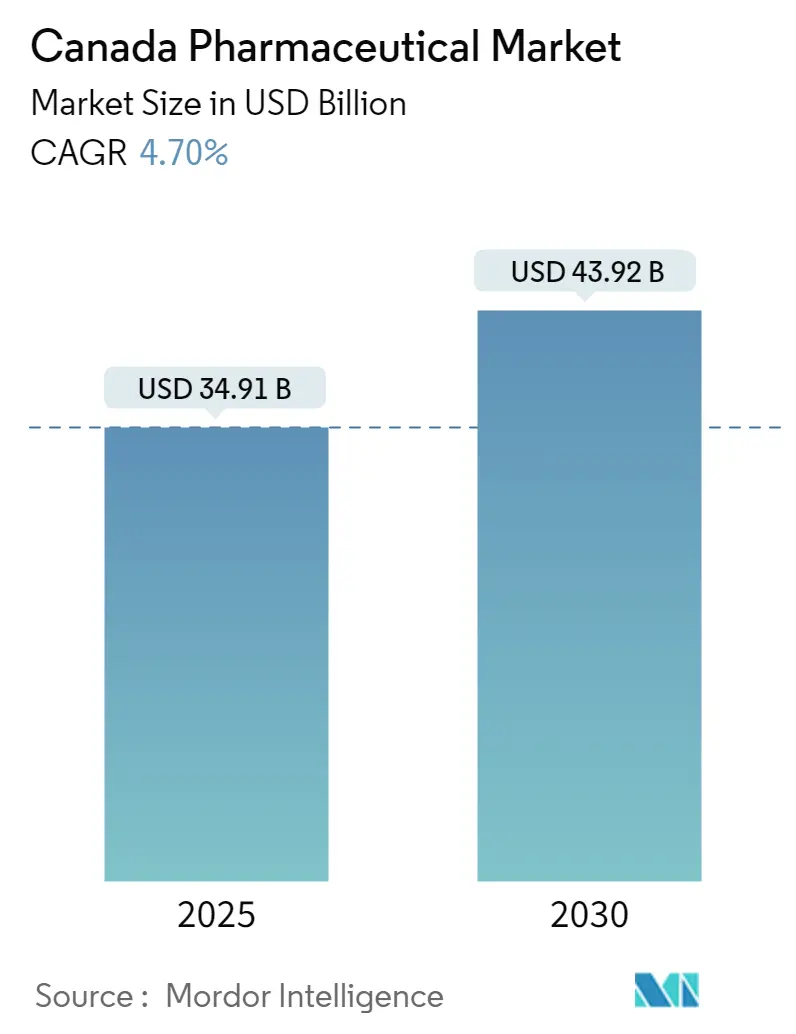
| Study Period | 2021 - 2030 |
| Base Year For Estimation | 2024 |
| Forecast Data Period | 2025 - 2030 |
| Market Size (2025) | USD 34.91 Billion |
| Market Size (2030) | USD 43.92 Billion |
| CAGR (2025 - 2030) | 4.70 % |
| Market Concentration | Medium |
Major Players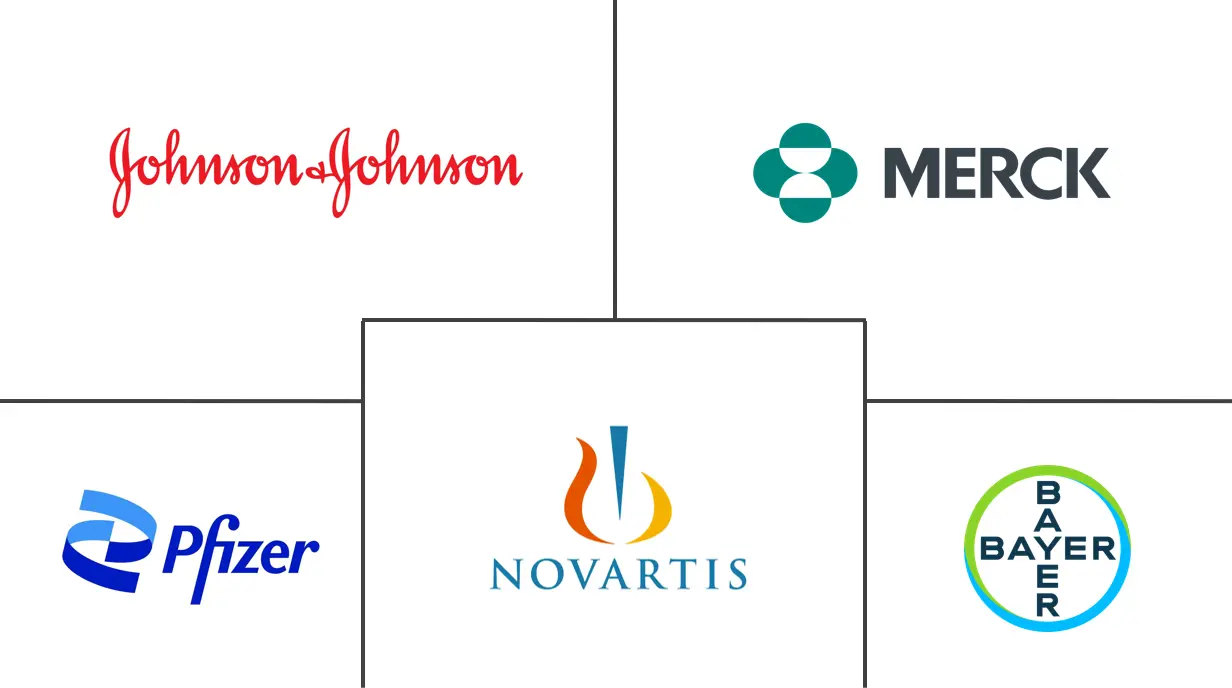
*Disclaimer: Major Players sorted in no particular order |
Canada Pharmaceutical Market Analysis
The Canada Pharmaceutical Market size is estimated at USD 34.91 billion in 2025, and is expected to reach USD 43.92 billion by 2030, at a CAGR of 4.7% during the forecast period (2025-2030).
Factors such as the rising geriatric population and growing incidence of chronic diseases among the population are expected to boost the growth of the pharmaceutical market in Canada over the forecast period.
The rising burden of chronic diseases such as cancer, cardiovascular diseases, neurological diseases, diabetes, and obesity among the population is the key factor driving the demand for various drugs for treatment, which may bolster the market’s growth over the forecast period. For instance, according to the Canadian Cancer Society 2023 report, about 27 people living in Canada were likely to be diagnosed with cancer every hour. About 239,100 new cases of cancer were estimated to be diagnosed in Canada in 2023. Thus, the country's high number of cancer patients is anticipated to fuel the demand for cancer-treating drugs, thus boosting market growth over the forecast period.
Additionally, according to the 2024 updated data published by the International Diabetes Federation, about 2.9 million people living in Canada had diabetes in 2021, and this number is projected to reach 3.2 million and 3.4 million by 2030 and 2045, respectively. Thus, the expected increase in the diabetic population raises the risk of developing other chronic diseases, such as cardiovascular and kidney diseases. This factor is anticipated to fuel the demand for drugs to treat diabetes conditions, propelling the market’s growth.
Furthermore, the growing aging population in the country is the key factor driving the demand for various drugs, which is anticipated to fuel the market’s growth over the forecast period. For instance, according to a 2022 report published by Statistics Canada, about 7.6 million people aged 65 and older were living in Canada in 2023, and this number is projected to reach 11 million by 2043. Thus, an increase in the geriatric population will eventually drive the demand for several medications, as this age group is more vulnerable to a variety of metabolic and lifestyle disorders, diminished bodily functions, cognitive impairment, and less mobility. Hence, these factors are anticipated to propel market growth.
Thus, owing to the rising prevalence of cancer and diabetes and the growing geriatric population, the market is expected to project growth over the forecast period. However, high costs associated with some pharmaceutical medications are expected to hinder the growth of the pharmaceutical market in Canada over the forecast period.
Canada Pharmaceutical Market Trends
The Alimentary Tract and Metabolism Segment is Expected to Register Significant Growth Over the Forecast Period
The alimentary tract consists of the mouth, esophagus, stomach, large intestine, small intestine, and anus, while metabolism is the internal process of the biochemical reactions involved in maintaining the living conditions of the cells in an organism. Increasing metabolic disorders and government support initiatives are key factors for the segment's growth.
The rising prevalence of gastric cancer, gastroesophageal reflux disease, and irritable bowel syndrome is increasing among the population, which necessitates the demand for effective treatment drugs, hence propelling the segment’s growth. For instance, according to the Canadian Cancer Society 2023 report, about 4,100 Canadians were diagnosed with stomach cancer in the country in 2022, and this number is projected to increase by 2025. Thus, the rising gastric cancer raises the demand for prescription drugs, further propelling the market growth.
Additionally, as per the 2023 report on Crohn’s and Colitis in Canada, it was observed that about 322,600 people in the country were living with irritable bowel syndrome in 2023, and this number is projected to increase to 470,000 in 2035. In addition to the above context, the number of new diagnoses is rising most rapidly in children under six years. Hence, the growing burden of irritable bowel syndrome among the population raises the need for immunosuppressive drugs, thereby contributing to segmental growth.
The government is also focusing on the country’s pharmaceutical industry, thus fueling the market’s growth. For instance, in June 2023, the Government of Canada invested USD 1 million, aligned with the Framework for Diabetes in Canada, which provides a common policy direction to focus efforts on addressing diabetes and ensuring better health outcomes for people in Canada. Diabetes Canada advances the Framework for Diabetes in Canada by convening individuals living with diabetes, key leaders in public health, diabetes care, and education, as well as cultural leaders and organizations, to share innovative and best practices to identify, prevent, and manage diabetes. Such investments are expected to contribute largely to the market’s growth in Canada.
Thus, the growing burden of gastric cancer and irritable bowel syndrome, along with the rising government funding and initiatives to ensure better health outcomes in the country, are anticipated to foster the growth of the segment over the forecast period.
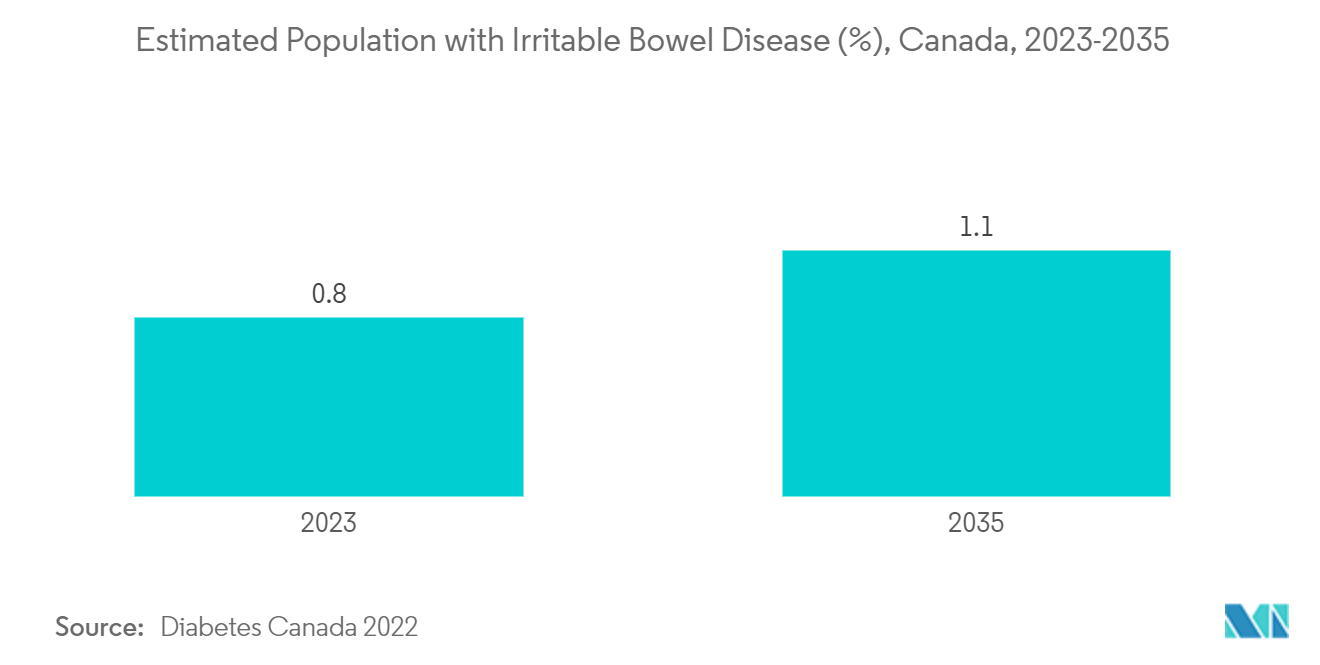
OTC Drugs are Expected to Witness Significant Growth During the Forecast Period
Over-the-counter (OTC) drugs are non-prescription drugs that can be purchased without a doctor's prescription. They are safe to use when following the directions on the label and as directed by the healthcare professional. The high cost of prescription drugs leading to a shift to OTC drugs, the rising approval of these drugs in Canada, and the growing incidents of infectious and chronic diseases are expected to boost the segment’s growth over the forecast period.
The increasing prevalence of topical disorders such as psoriasis, vitiligo, eczema, atopic dermatitis, and phimosis in Canada is one of the leading factors responsible for the segment’s growth. For instance, according to the 2023 data published by the Canadian Skin Patient Alliance (CSPA), atopic dermatitis is one of the most frequently diagnosed skin conditions, particularly common in young children and infants. Atopic dermatitis is often characterized as itchy, inflamed skin. It is the most common form of eczema, thus raising the demand for OTC products, such as ointments, creams, antihistamines, antibiotics, and lotions. This growing demand for OTC products is anticipated to propel the segment's growth over the forecast period.
Similarly, as per the Government of Canada’s 2024 FluWatch report, about 1,193 laboratory-confirmed influenza outbreaks were reported in the country from August 27, 2023, to April 27, 2024, compared to about 1,178 laboratory-confirmed influenza outbreaks reported from August 27, 2023, to April 20, 2024. This data shows the rising burden of influenza cases across Canada, thus fueling the demand for pain-relieving drugs in the market and driving the segment’s growth.
Additionally, strategic activities such as partnerships and acquisitions adopted by key players are likely to contribute to the segment’s growth. For instance, in February 2022, Galderma and Taro Pharmaceutical Industries Ltd signed a definitive agreement for Taro to acquire Alchemee, formerly The Proactiv Company (TPC), from Galderma. The agreement between Galderma and Taro includes Alchemee's business and assets worldwide, including the Proactiv brand. Taro Pharmaceutical Industries Ltd has a broad portfolio of OTC dermatology products. This acquisition will help the company expand its product portfolio across Canada.
Adults aged 65 years and older accounted for 48% of reported hospitalizations in Canada. The highest cumulative hospitalization rates were among adults aged 65 years and older (108/100,000) and children under the age of 5 years (66/100,000). Thus, the high infection cases are likely to boost the demand for OTC products such as decongestants, analgesics, and other medications that can help with problems like coughing and sneezing.
Therefore, with the increasing prevalence of diseases such as atopic dermatitis in Canada, the segment is expected to grow strongly in the coming years.
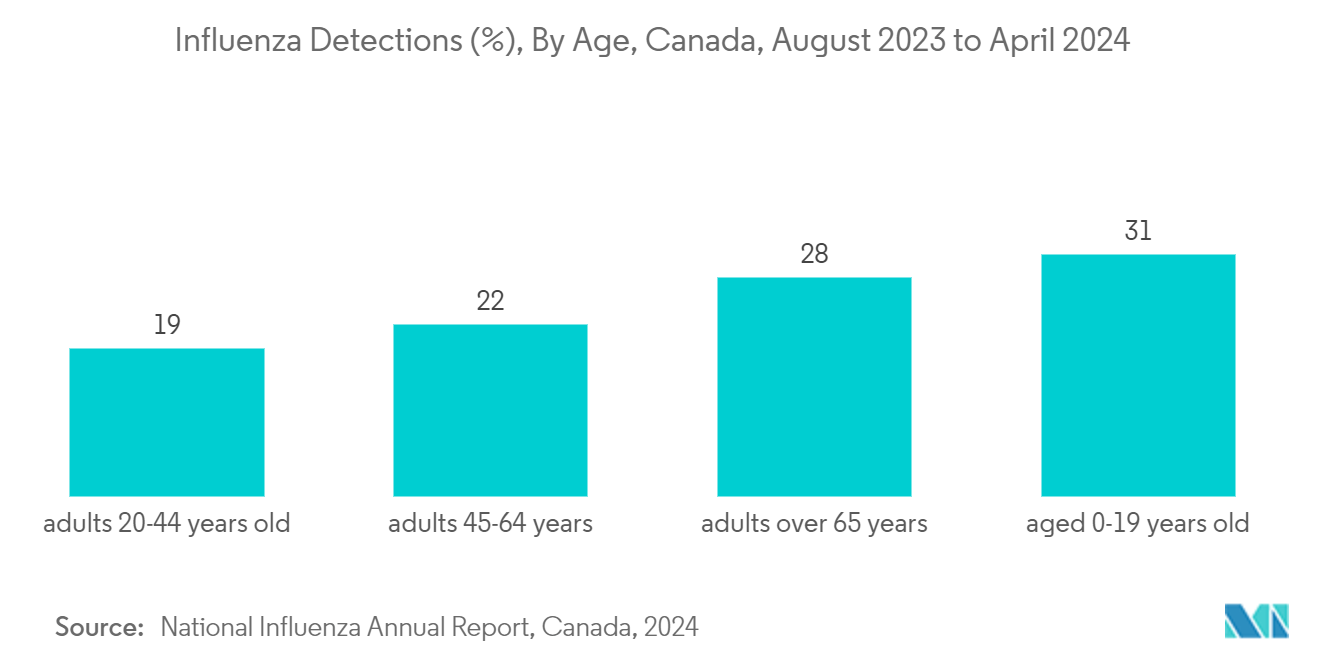
Canada Pharmaceutical Industry Overview
The Canadian pharmaceutical market is highly competitive and consists of several major players. A few of the major players are currently dominating the market in terms of market share. Some prominent players are vigorously making acquisitions and joint ventures with other companies to consolidate their market positions in the country. Some key companies currently dominating the market are Johnson & Johnson, Novartis AG, Merck & Co. Inc., Pfizer Inc., and Bayer AG.
Canada Pharmaceutical Market Leaders
-
Johnson & Johnson
-
Merck & Co., Inc.
-
Pfizer Inc.
-
Bayer AG
-
Novartis AG
- *Disclaimer: Major Players sorted in no particular order
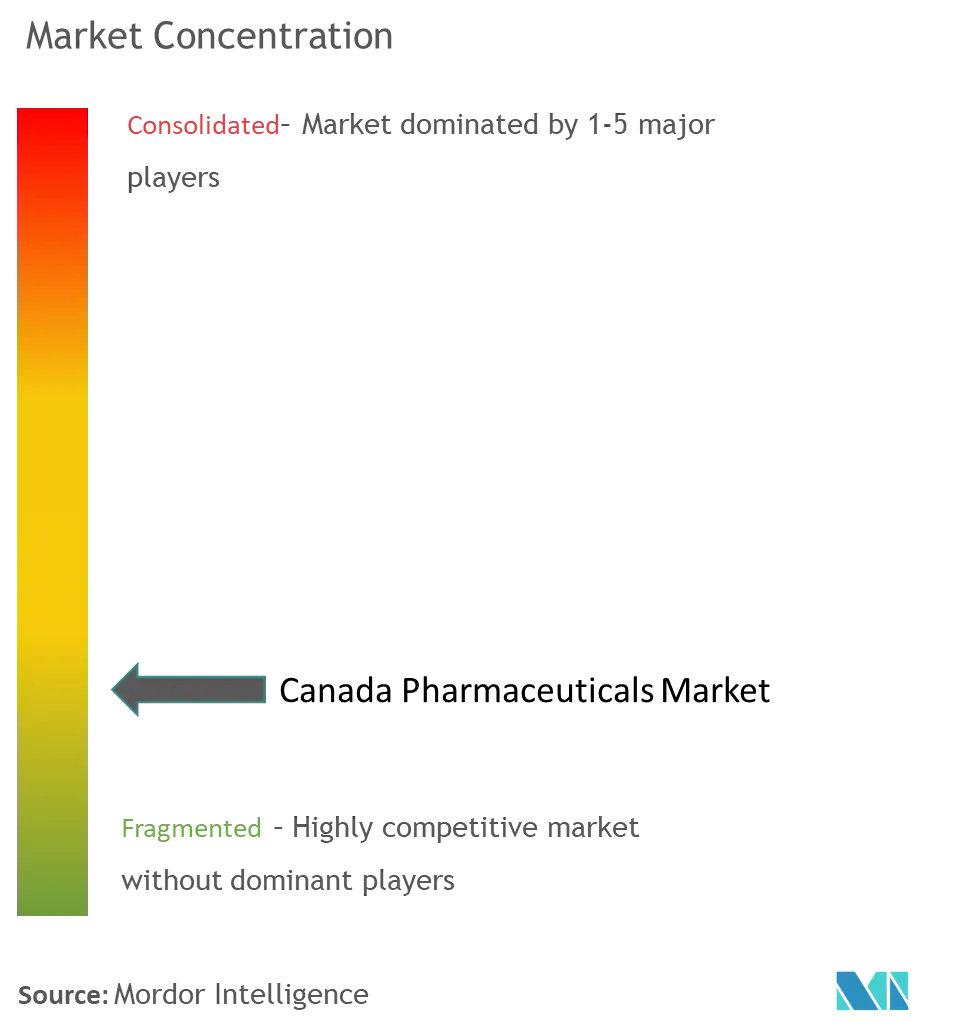
Canada Pharmaceutical Market News
- October 2023: Panacea Biotec launched Paclitaxel protein-bound particles for injectable suspension (albumin-bound), which is indicated for the treatment of metastatic breast cancer, non-small cell lung cancer, and adenocarcinoma of the pancreas in the Canadian market through its strategic partner, Apotex Inc. of Canada.
- March 2023: Natco Pharma introduced a generic version of the cancer drug Pomalidomide Capsules in Canada. It is the first generic alternative to Celgene Corporation’s Pomalyst brand in the country, approved by Health Canada. Pomalidomide is used in combination with Dexamethasone and Bortezomib for the treatment of multiple myeloma in adults.
Canada Pharmaceutical Industry Segmentation
As per the scope of this report, pharmaceuticals are referred to as medications or medicinal drugs intended to prevent, diagnose, treat, or cure a disease. They may be prescription or non-prescription drugs. The Canadian pharmaceutical market is segmented by ATC/therapeutic class and drug type. The ATC/therapeutics class is segmented by Alimentary tract and metabolism, blood and blood-forming organs, cardiovascular system, dermatological, Genito urinary system and sex hormones, systemic hormonal preparations, antiinfectives for systemic use, antineoplastic and immunomodulating agents, musculoskeletal system, nervous system, antiparasitic products, insecticides and repellents, respiratory system, sensory organs, and various other ATC/therapeutic classes. The drug type segment is further bifurcated into prescription type and OTC drugs. Prescription type is segmented into branded and generic. The report offers the value (in USD) for the above segments.
| By ATC/Therapeutic Class | Alimentary Tract and Metabolism | ||
| Blood and Blood-forming Organs | |||
| Cardiovascular System | |||
| Dermatologicals | |||
| Genito Urinary System and Sex Hormones | |||
| Systemic Hormonal Preparations | |||
| Antiinfectives for Systemic Use | |||
| Antineoplastic and Immunomodulating Agents | |||
| Musculoskeletal System | |||
| Nervous System | |||
| Antiparasitic Products, Insecticides, and Repellents | |||
| Respiratory System | |||
| Sensory Organs | |||
| Various Other ATC/Therapeutic Classes | |||
| By Drug Type | By Prescription Type | Branded | |
| Generic | |||
| OTC Drugs | |||
Canada Pharmaceutical Market Research FAQs
How big is the Canada Pharmaceutical Market?
The Canada Pharmaceutical Market size is expected to reach USD 34.91 billion in 2025 and grow at a CAGR of 4.70% to reach USD 43.92 billion by 2030.
What is the current Canada Pharmaceutical Market size?
In 2025, the Canada Pharmaceutical Market size is expected to reach USD 34.91 billion.
Who are the key players in Canada Pharmaceutical Market?
Johnson & Johnson, Merck & Co., Inc., Pfizer Inc., Bayer AG and Novartis AG are the major companies operating in the Canada Pharmaceutical Market.
What years does this Canada Pharmaceutical Market cover, and what was the market size in 2024?
In 2024, the Canada Pharmaceutical Market size was estimated at USD 33.27 billion. The report covers the Canada Pharmaceutical Market historical market size for years: 2021, 2022, 2023 and 2024. The report also forecasts the Canada Pharmaceutical Market size for years: 2025, 2026, 2027, 2028, 2029 and 2030.
Our Best Selling Reports
Pharmaceutical in Canada Industry Report
Canada's pharmaceutical market is experiencing a period of significant growth, driven by an aging population, a rise in chronic diseases, and advancements in healthcare technologies. This growth is supported by the presence of both major international and innovative smaller companies, capitalizing on Canada's strong intellectual property laws and high-quality R&D environment. The market, with its diverse segments including formulation types, routes of administration, and prescription types, is set for considerable expansion. Key growth drivers include the increasing geriatric population and chronic diseases, boosting medication demand, alongside the adoption of new technologies like automated dispensing and electronic prescription systems to improve efficiency. However, challenges such as intense competition, market saturation, and stringent regulations may hinder growth. Trends like the rising demand for OTC drugs and growth in segments like alimentary tract and metabolism, due to the increasing prevalence of metabolic disorders and continuous product launches, indicate a dynamic market. With detailed segmentation and a forecast outlook provided by industry reports, the Canadian pharmaceutical market is poised for robust growth, reflecting the evolving healthcare landscape. Get a sample of this industry analysis as a free report PDF download.




